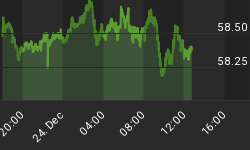Market's Next Move Hangs In The Balance
With Larry Summers out of the picture, the financial markets are facing two key questions:
- What does Janet Yellen want to do with interest rates?
- Will the market believe the Fed's low rate pledge?
Yellen Controlling Fed's Simulator

The markets knew Janet Yellen was more apt to blow low-rate-induced asset bubbles than Larry Summers, which explains the pop in the futures on Sunday night. The question now becomes what is Janet Yellen's stance on longer-term interest rate policy in the face of an improving economy. From The Wall Street Journal:
Janet Yellen, the Fed's vice chairwoman and a contender to become next Fed chief, in two 2012 speeches pointed to computer models that work something like flight simulators. They spit out estimates for the federal funds rate that best produces low unemployment and stable inflation based on estimates of how the economy normally behaves. These "optimal control" models have pointed to the benefits of a low fed funds rate far into the future even as unemployment declines.
Market's Expectation: $10B Taper

The Fed has been telegraphing a tapering announcement for over four months. As we have outlined on numerous occasions, the desire to taper is primarily based on fear of asset bubbles, rather than confidence in the economy. Following a less than stellar August monthly employment report, the markets have lowered their tapering expectations. From Bloomberg:
Fed policy makers meeting Sept. 17-18 will probably lower the monthly pace of bond purchases by $10 billion, to $75 billion, according to the median response of 34 economists in a Bloomberg News survey on Sept. 6. That's down from expectations of a $20 billion reduction in a July survey.
Pledging vs. Printing
The Fed's game plan is to try to get the markets to focus on low rates rather than the end of quantitative easing (QE). Said another way, the Fed is trying to calm markets with "pledging rather than printing". The Fed's shift in strategy was first disclosed in late May when Ben Bernanke used the term taper. Since the taper cat has been out of the bag, interest rates have shot higher.

But, You Said The Economy Was Improving

We believe the base case continues to lean toward a tapering announcement Wednesday since the Fed has to be debating the following question: what type of message would it send about the strength of the economy if we fail to taper now? The problem on the other end of the spectrum is if the Fed says they are confident about future economic outcomes, then how does that align with keeping interest rates low for an extended period? From The Wall Street Journal:
As the economy improves, the Fed is trying to shift its emphasis from bond buying, which has uncertain costs and benefits, to the low-rate pledge. Explaining the path of rates far in the future will get more complicated when the Fed releases its 2016 forecasts for the first time on Wednesday. Those forecasts are likely to show an unemployment rate within the 5.2% to 6% range that officials believe is normal in the long run and an inflation rate near the Fed's 2% target. The Fed's most recent public forecast, made in June, showed the jobless rate right around 6% by the fourth quarter of 2015 and inflation near 2%.
Investment Implications
There are two major scenarios regarding tapering and the end of QE:
Scenario One: If the markets believe the underlying economy is strong enough, interest rates will rise and the stock market should continue to rise as well.
Scenario Two: If the markets believe the primary reason for tapering is fear of asset bubbles rather than economic confidence, the risk-off trade may rear its ugly head.
The markets, and our portfolios, are currently aligned with Scenario One. However, interest rates appear to be near a possible inflection point (see chart below). If fear allows Scenario Two to take the driver's seat after the Fed begins to taper, interest rates may fall and stocks could begin a sideways-to-down trend as they did near points A1 and B2.

If Scenario One continues to carry the day, we are properly positioned in stocks (VTI), and leading U.S. sectors, including small caps (IWM) and technology (QQQ). Our exposure to emerging markets (EEM) and a diversified basket of foreign stocks (EFA) is also appropriate under Scenario One conditions. If Scenario Two begins to take hold of the market's asset pricing mechanism, our market model will allow us to prudently migrate away from stocks (SPY) and toward more conservative assets, such as bonds (AGG).
















